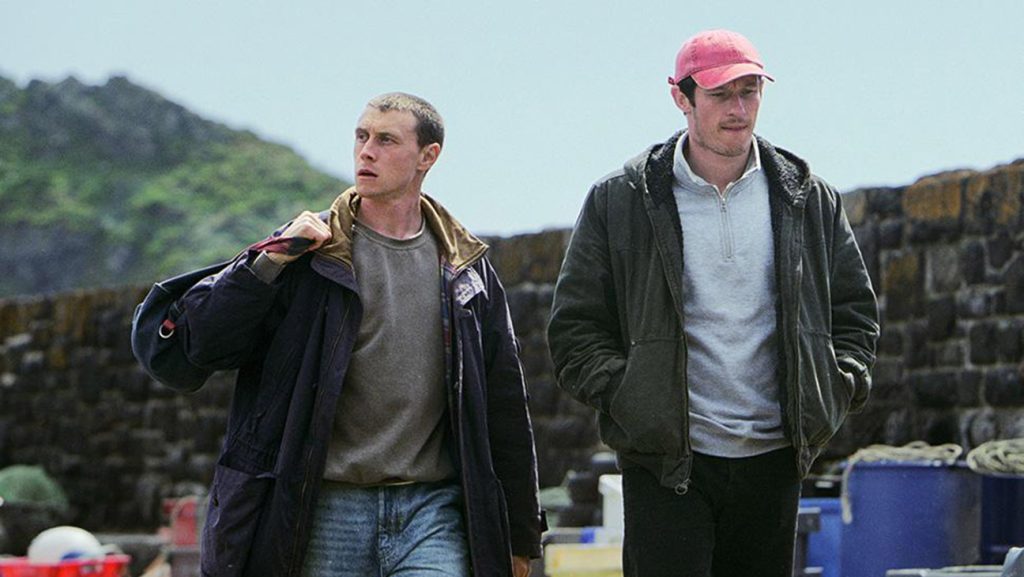Rose of Nevada is a haunting narrative that transcends traditional ghost stories, showcasing the creativity of director Mark Jenkin. Unlike his previous film, Enys Men (2022), this one features recognizable actors and a clearer storyline. However, the plot is far from linear; it revisits themes and questions of existence while enveloping viewers in striking visuals and a ghostly ambiance.
The film also introduces an unsettling time-travel element, significantly enhanced by the grounded performance of George MacKay (1917 and The Beast). He portrays Nick, a local man grappling with a failing fishing village in Cornwall. Nick’s struggles include relying on a food bank and dealing with a leaky roof that affects his wife and young daughter. Meanwhile, Callum Turner portrays Liam, a mysterious newcomer without money or shelter.
Rose of Nevada
The Bottom Line
Elegant and enigmatic.
Venue: Venice Film Festival (Horizons)
Cast: George MacKay, Callum Turner, Rosalind Eleazar, Francis Magee, Mary Woodvine, Adrian Rawlins, Edward Rowe
Director and writer: Mark Jenkin
1 hour 54 minutes
A small fishing boat named Rose of Nevada, lost for 30 years, mysteriously returns to shore. Two men vanished with it: one was the husband of Tina (Rosalind Eleazar), who has two daughters oblivious to their father’s fate. The other was the son of Nick’s neighbors, the Richards (Mary Woodvine and Adrian Rawlins). Mrs. Richards, confused but resolute, declares to Nick, “My boy’s coming home,” foreshadowing supernatural elements. Jenkin appears to have a personal connection to lost fishermen, a recurring theme in his body of work.
Right from the start, Jenkin intertwines his signature visual style with the narrative of Nick and Liam, who join the recovered boat’s skipper on fishing excursions. The film opens with grainy shots reminiscent of old footage, highlighting decayed elements that later reveal to be part of the rotting vessel.
While Enys Men unfolds with a series of disconnected scenes, Rose of Nevada successfully builds suspense. During a fishing trip, Nick discovers a warning etched on his bunk: “Get Off the Boat Now.” Upon returning, Nick and Liam find themselves in 1993, witnessing a revitalized town and questioning whether they are trapped in the past or if another ocean journey can lead them back to their present.
MacKay’s portrayal of Nick is filled with torment, indicative of a man struggling to provide for his family. This time-travel aspect hints at deeper motivations behind his expression, although it remains poignant without veering into melodrama. Nick’s disorientation in the past is palpable, contrasting sharply with his yearning to reunite with his family. While Turner’s character, Liam, feels somewhat underdeveloped, he grows more intriguing in the 1993 setting. Eleazar delivers a versatile performance across both timelines, keeping viewers guessing about Tina’s knowledge of the situation.
The image of the two lost men frequently resurfaces, raising questions about what truly happened to them. Nick’s dreams could suggest memories, enhancing the film’s exploration of identity and family bonds. Although Jenkin’s emphasis on visual storytelling occasionally clashes with the narrative flow—particularly through repetitive shots of fish—his style remains visually impressive. As a multifaceted creator, Jenkin assumes the roles of writer, director, cinematographer, and editor, also crafting the sound design, which plays a vital role in creating an unnerving atmosphere without slipping into horror clichés.
In a director’s statement, Jenkin highlights themes of “personal sacrifice, community strength, and societal belonging.” While these themes might not resonate strongly for all viewers, his masterful artistry opens the floor for individual interpretation and reflection.



